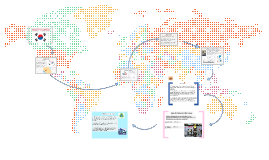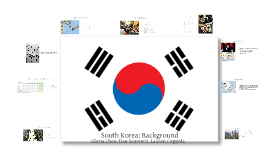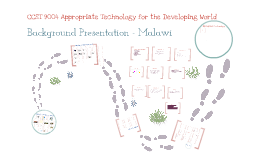South Korea: Background
Transcript: South Korea: Background South Korea gained independence from Japan in 1945 Type of government is a Republic The President is Lee Myung-bak Currency= Won Korean is the offical language English is widely taught throughtout Religions No affiliation- 46%, Christianity-26%, Buddhist-26%, Confusciast-1%, Other 1% In 2005, 42% of South Korea’s work force was women. Food-Rice, beans, vegetables, fish and meat. Teenage Life: Unlike America, students are to focus solely on their academics and are not allowed to work while they go to school. Students have carrels where their books are kept and where they study on their own. Like America they will join sports teams. Driving age is 20 Gloria Chen, Dan Scorzetti, Lauren Coppola Culture The Gross Domestic Product: US $ 1,014 billion GDP Growth Rate: 6.2% GDP per capita of South Korea: US $ 20,759 Labor Force Size: 24.62 million Labor force in sectors: 68.4%; industry--24.3%; agriculture--7.3% Unemployment: 3.3%. Imports:US$400.6 billion Exports:US$441.5 billion natural resources: Coal, tungsten, graphite, molybdenum, lead, hydropower potential Population Density - 501 people per square mile South Korea is in Eastern Asia with the southern half of the Korean Peninsula bordering the East Sea and the Yellow Sea The surface area is 99900.00 sq. miles in 2010 Demographics Neighboring Countries: North Korea, Japan across the East Sea and China across the Yellow Sea. Total Population: 48.87 Million Population Growth:0.26% Median Age: 38 years Telephone Main: 26.6 million (2004) Mobile: 45.6 million (2009) Population of 48.6 million (2009) Tech-savvy country "We want to make the cellphone the center of life." - SK Telecom Any Questions? Basic Information Communication Infrastructure Physical Infrastructure Government Economics Geography Life expectancy : Male, 77 years; Female, 83.8 years. Literacy rate of adults: Total population: 97.9% Male: 99.2% Female: 96.6% Infant mortality rate of South Korea is :6.05 deaths/1,000 live births The age structure: 0-14 years: 18.3% (male4,714,103/female 4,262,873) 15-64 years: 72.1% (male18,004,719/female 17,346,594) 65 years and over: 9.6% (male1,921,803/female 2,794,698) Very advance and modern Expanding since the 1960s Roads Paved: 40,272 miles Unpaved: 13,784 miles Port Cities Chinhae, Inchon, Kusan, Masan, Mokpo, Pohang, Pusan, Tonghaehang, Ulsan and Yosu

















